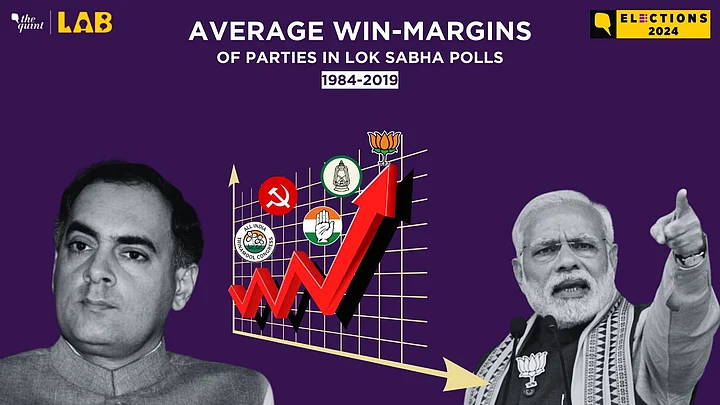Does higher seat-tally in Lok Sabha also mean higher win-margins for parties in the winning seats? Or does a hung Parliament mean lower victory-margins and close contests?
The data of Lok Sabha elections since 1984 indicate an affirmative answer to the above question. Which means that more decisive the mandate, more is the average win-margin of the winning party.
The below interactive infographic shows how:
Win-margin is the difference between vote-share of the winner and the runner-up candidate. Average win-margin of a party is calculated by dividing the sum of the win-margins across constituencies by the total number of winning candidates of that party in a particular election. The average helps evening out the differing factors of constituencies like number of electors, voter-turnouts, etc.
The Lok Sabha election data from 1984 shows that whenever a national party received an absolute majority, their average win-margins on the seats won also go up.
For instance, the 1984 Lok Sabha election, which got Congress the historic seat-count (404 seats) and vote-share (49%), is also the election where Congress candidates registered biggest average win-margin for the party i.e. 22.6%.
However, during the coalition-era of 1990s, when Lok Sabha elections were repeatedly resulting in hung Parliament, the average win-margins saw a continuous fall. A change of few dozen seats didn't affect the win-margins of the party. For instance, despite BJP losing 44 seats from 1999 to 2004, its average win-margin dropped marginally i.e. from 10.3% to 10.6%. Or when Congress' seat count grew by 51 between 1999 and 2004 elections, it's average win-margin saw a slight growth from 11.8% to 9.6%.
But when BJP stormed into power with a majority in 2014. The massive change of 116 seats also reflected in it win margin which swelled from 8.9% in 2009 to 18% in 2014. This trend persisted in the 2019 elections as well.
(At The Quint, we question everything. Play an active role in shaping our journalism by becoming a member today.)
